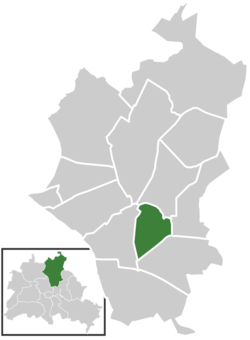Berlin-Heinersdorf
| Heinersdorf | |
|---|---|
| Quarter of Berlin | |

Heinersdorf Church
|
|
| Coordinates: 52°34′01″N 13°26′24″E / 52.56694°N 13.44000°ECoordinates: 52°34′01″N 13°26′24″E / 52.56694°N 13.44000°E | |
| Country | Germany |
| State | Berlin |
| City | Berlin |
| Borough | Pankow |
| Founded | 1319 |
| Area | |
| • Total | 3.95 km2 (1.53 sq mi) |
| Elevation | 90 m (300 ft) |
| Population (2008-06-30) | |
| • Total | 6,580 |
| • Density | 1,700/km2 (4,300/sq mi) |
| Time zone | CET/CEST (UTC+1/+2) |
| Postal codes | (nr. 0304) 13089 |
| Vehicle registration | B |
Heinersdorf is a locality in the borough of Pankow in Berlin, Germany. It is located close to the centre of Pankow.
It was first mentioned in a 1319 document when it was sold by Margrave Waldemar of Brandenburg to the Hospital of the Holy Ghost in Berlin. After that it changed its owner several times. In 1920 it was incorporated into Greater Berlin and belonged to the former Pankow borough, until in 1985 it was merged with Karow, Blankenburg and Weissensee. These localities belong to Pankow again after Berlin's 2001 administrative reform.
The foundations of the fieldstone church were laid about 1300. It features two stained glass windows by Charles Crodel from 1946. Another landmark is the Heinersdorf water tower, which was erected in 1910. Original part of a planned town hall that has never been built, it later served as a Flak tower and as a listening station of the Red Army. Since 1991 the building is abandoned.
Nowadays Heinerdorf is often in the media due to a controversy on the establishment of the Khadija Mosque by the Ahmadiyya Muslim Community.
Heinersdorf is served by the Berlin S-Bahn lines S2 and S8 at the Pankow-Heinersdorf station. A tramway connection to the inner city is provided by the M2 line of the Berlin Straßenbahn.
...
Wikipedia


